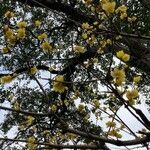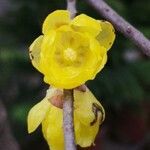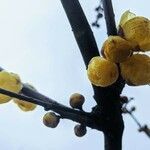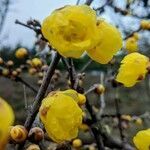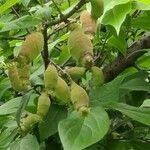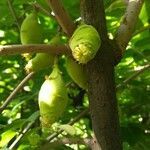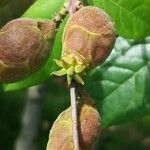Shrubs or small trees, 3-13 m tall, deciduous or sometimes with persistent leaves. Branchlets grayish brown, quadrangular when young but becoming subterete, glabrous or slightly puberulent, lenticellate; buds usually axillary on branches of previous year; bud scales subcircular, imbricate, outside pubescent. Petiole 0.3-1.8 cm, pubescent; leaf blade ovate, elliptic, broadly elliptic, ovate-elliptic, oblong-elliptic, or sometimes oblong-lanceolate, 5-29 × 2-12 cm, papery to subleathery, abaxially glabrous except for occasional scattered trichomes on veins, adaxially roughly scabrous, secondary veins 4-6 on each side of midvein, base cuneate to rounded, apex acute, acuminate, or sometimes caudate. Flowers on branches of previous year, solitary or paired, appearing generally before leaves, 1.5-4 cm in diam., sweetly fragrant. Pedicel 2-8 mm. Tepals 15-21, yellow but inner ones usually with purplish red pigment, 0.5-2 × 0.5-1.5 cm; outer tepals orbicular to obovate, puberulent, apex truncate or rounded; median tepals elliptic to oblong-elliptic, glabrous or sometimes margin ciliate, apex rounded to acute; inner tepals orbicular to oblong, glabrous or sometimes margin ciliate, base distinctly clawed, apex rounded. Stamens 5-8, 2.5-4 mm; filaments broad, longer, equal, or rarely shorter than anthers, basally pubescent or glabrous; anthers glabrous; connective puberulous or glabrous, apex acute; staminodes 2-15, subulate to linear-lanceolate, 2-3 mm, pubescent. Carpels 5-15, hirtellous at base; style ca. 3 × as long as ovary, pubescent at base. Pseudocarp urceolate, ovoid-ellipsoid, or obovoid-ellipsoid, 2-6 × 1-2.5 cm, subwoody, apex constricted, apical appendages 9 or 10, tapered lanceolate, with trichomes. Achenes 3-11, brown, ellipsoid to reniform, 15-16.5 × 5-5.6 mm, pubescent at base. Fl. Oct-Mar, fr. Apr-Nov. 2n = 22*.
More
A deciduous shrub. It grows 3-3.7 m tall and spreads 2.5-3 m wide. The stems are thick and angular. The leaves are sword shaped and 20 cm long. The leaves are glossy and mid green. They have a rough surface. They turn pale yellow in autumn. The flowers are dull pale yellow and almost without stalks. There is a small maroon inner section. They have a sweet scent. The fruit are yellow-brown when ripe.
